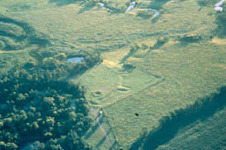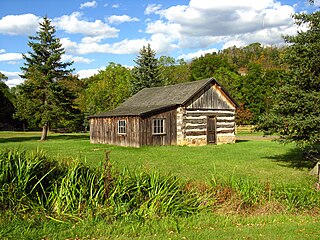Archeological Site No. LA 54049 | |
| Nearest city | Animas, New Mexico |
|---|---|
| Area | 49.4 acres (20.0 ha) |
| MPS | Animas Phase Sites in Hidalgo County MPS |
| NRHP reference No. | 92001813 [1] |
| NMSRCP No. | 1326 |
| Significant dates | |
| Added to NRHP | January 23, 1993 |
| Designated NMSRCP | October 24, 1986 |
Archeological Site No. LA 54049 is a prehistoric archaeological site in Hidalgo County, New Mexico. The site was inhabited during the Animas phase (1200-1350 A.D.); it may have also had a Mimbres phase occupation in 1000-1150 A.D. The site's most distinctive feature consists of two stone lines, each roughly 30 metres (98 ft) long and separated by a 29-metre (95 ft) gap. While the purpose of the lines is uncertain, they may have demarcated a court for some sort of ball game. The site also includes a large lithic scatter and numerous ceramic fragments. [2]
The site was added to the National Register of Historic Places on January 23, 1993. [1]

Aztalan State Park is a Wisconsin state park in the Town of Aztalan, Jefferson County. Established in 1952, it was designated a National Historic Landmark in 1964 and added to the National Register of Historic Places in 1966. The park covers 172 acres (70 ha) along the Crawfish River.

The Menoken Indian Village Site, also known as Menoken Site, Verendrye Site or Apple Creek Site is an archeological site near Bismarck, North Dakota. The site, that of a fortified village occupied c. 1300, is important in the region's prehistory, as it is one of the only sites that predates sites that are more clearly associated with the historic Hidatsa, Mandan, and Arikara cultures. It was declared a National Historic Landmark in 1964, and was listed on the National Register of Historic Places in 1966. It is located on 171st Street NE, north of Menoken, about 10 miles (16 km) east of Bismarck. The site managed by the state as the Menoken Indian Village State Historic Site, and is open to the public.

Mesilla Plaza is the central plaza in the small town of Mesilla in far southern New Mexico. The plaza and a number of its surrounding buildings are a National Historic Landmark District, significant for its role in the transfers of power that brought first the original New Mexico Territory and later the Gadsden Purchase into United States control. The most notable building facing the plaza is the Basilica of San Albino, which has been on the plaza since its establishment in 1851. The plaza was declared a National Historic Landmark in 1961.
The Aden site is an archaeological site that is the type site for the Aden phase of Lower Yazoo Basin Coles Creek culture chronology. It corresponds to Middle Coles Creek, chronologically between the Bayland phase and Kings Crossing phase.

This is a list of the National Register of Historic Places listings in Hidalgo County, New Mexico.

The Canfield Island Site, also known as Archeological Site 36LY37, is an archaeological site in Lycoming County, Pennsylvania, United States. Located on Canfield Island in the West Branch Susquehanna River, the site lies east of the city of Williamsport in Loyalsock Township. It is believed to have been inhabited by prehistoric Native Americans for thousands of years, with the oldest discoveries dating back to more than one millennium before Christ.

The Bedford Village Archeological Site (36BD90) is an archaeological site in central Bedford County, Pennsylvania, United States. Located in Bedford Township north of the borough of Bedford, it was once occupied by a Monongahela culture village. Today, the site is the location of Old Bedford Village, an open-air museum, containing a variety of historic structures transported to the site from the surrounding towns of Bedford, Everett, and Rainsburg.

The Adams site (15FU4) is a Mississippian culture archaeological site located near Hickman in Fulton County, Kentucky, on Bayou de Chien, a creek that drains into the nearby Mississippi River.

This is a list of the National Register of Historic Places listings in Hidalgo County, Texas
The Trinchera Cave Archeological District (5LA9555) is an archaeological site in Las Animas County, Colorado with artifacts primarily dating from 1000 BC to AD 1749, although there were some Archaic period artifacts found. The site was added to the National Register of Historic Places in 2001 and is located on State Trust Lands.

Foster's Mound is a Plaquemine culture archaeological site located in Adams County, Mississippi northeast of Natchez off US 61. It is the type site for the Foster Phase of the Natchez Bluffs Plaquemine culture chronology. It was added to the NRHP on September 2, 1982 as NRIS number 82003091. The mounds are listed on the Mississippi Mound Trail.
Mantle's Cave is a cliff alcove in Dinosaur National Monument in Moffat County, Colorado. Located in the Castle Park region of the park, it is the largest rock shelter in the area. It was discovered before 1921 by local ranchers, Mr. and Mrs. Charles Mantle. Mrs. Mantle is reported to have done some excavation of the site, followed up by the Penrose-Taylor expedition of 1933 from Colorado College and the Fountain Valley School, which designated the site "Cave One." The site is a significant resource for the Fremont culture and is among the best resources in northwestern Colorado. Excavations in the 1930s and 1940s yielded significant material on the Fremont people and their relationship to the later Ancestral Puebloans.

The Initial Point of Boundary Between U.S. and Mexico is the westernmost boundary marker on the international boundary between the United States and Mexico and as such has since its erection marked the southwestern corner of the Continental United States. According to the 1848 Treaty of Guadalupe Hidalgo, the initial border point is set as one marine league south of the southernmost point of San Diego Bay, and the border proceeds in a straight line towards the confluence of the Colorado River and Gila River.
The Alamo Hueco Site is a prehistoric archaeological site in Hidalgo County, New Mexico. The site was inhabited from 600 to 1350 A.D., a period which spanned the San Luis phase, the Mimbres phase, and the Animas phase. The inhabitants of the site built several adobe mounds; while the mounds have been extensively vandalized, two large mounds still contain hundreds of rooms and significant cultural deposits. Materials recovered from the site include ceramics, lithic scatters, and cobbles.
The Box Canyon Site is a prehistoric archaeological site in Hidalgo County, New Mexico. The site was occupied during the Animas phase (1200–1350); some artifacts may also date from the Salado phase (1350–1450) The principal feature of the site is an adobe house mound containing more than 100 rooms. A 1962 excavation explored 18 of the rooms; artifacts recovered from the investigation include ceramics, stone and metal flakes, and some cobbles.
Archeological Site No. LA 54050 is a prehistoric archaeological site in Hidalgo County, New Mexico. The Animas phase site was inhabited from roughly 1200 to 1350 A.D. Its principal feature is a 1-metre tall adobe mound with about 50 rooms. Another adobe block to the south of the main mound may contain another 50 rooms, though it has not been fully investigated. A lithic scatter is located to the west of the main site. Artifacts recovered from the site include ceramics, cobbles, and projectile points.
Archeological Site No. LA 54042 is a prehistoric archaeological site in Hidalgo County, New Mexico. The site was inhabited during the Animas phase ; some artifacts may also date from the Salado phase A small adobe structure with one to three rooms sits on the east side of the site; it is surrounded by scattered cobbles and ceramics. The structure's small size suggests that it was used as some sort of temporary building, possibly as a field house. The remainder of the site consists of dispersed lithic shards with a relatively low density.
Archeological Site No. LA 54021 is a prehistoric archaeological site in Hidalgo County, New Mexico. The site dates from the Animas phase, which spanned from 1200-1350 A.D. Adobe structures with at least 16 total rooms have been found at the site; these structures may represent a transitional phase between pit dwellings and larger Animas compounds. Six of these rooms are filled in with soil and retain their cobble foundations and parts of their adobe walls. The site also includes ceramic remains and some stone artifacts.
The Carson Mounds,, also known as the Carson Site and Carson-Montgomery- is a large Mississippian culture archaeological site located near Clarksdale in Coahoma County, Mississippi in the Yazoo Basin. Only a few large earthen mounds are still present at Carson to this day. Archaeologists have suggested that Carson is one of the more important archaeological sites in the state of Mississippi.

The McCune Mound and Village Site is a prehistoric archaeological site located in Whiteside County, Illinois near the city of Sterling. The site consists of a single mound, 3 metres (9.8 ft) high and 23 metres (75 ft) in diameter, and five depressions that may have been housing sites. The site was occupied by Upper Mississippian peoples from roughly 1200 to 1500 A.D.; it is considered part of the Langford tradition, a subset of Upper Mississippian culture found in northwestern Illinois. Modern archaeologists first documented the site in 1961. As a relatively intact site with a single-component habitation, the site was considered to have the potential to provide significant information on the Langford tradition.